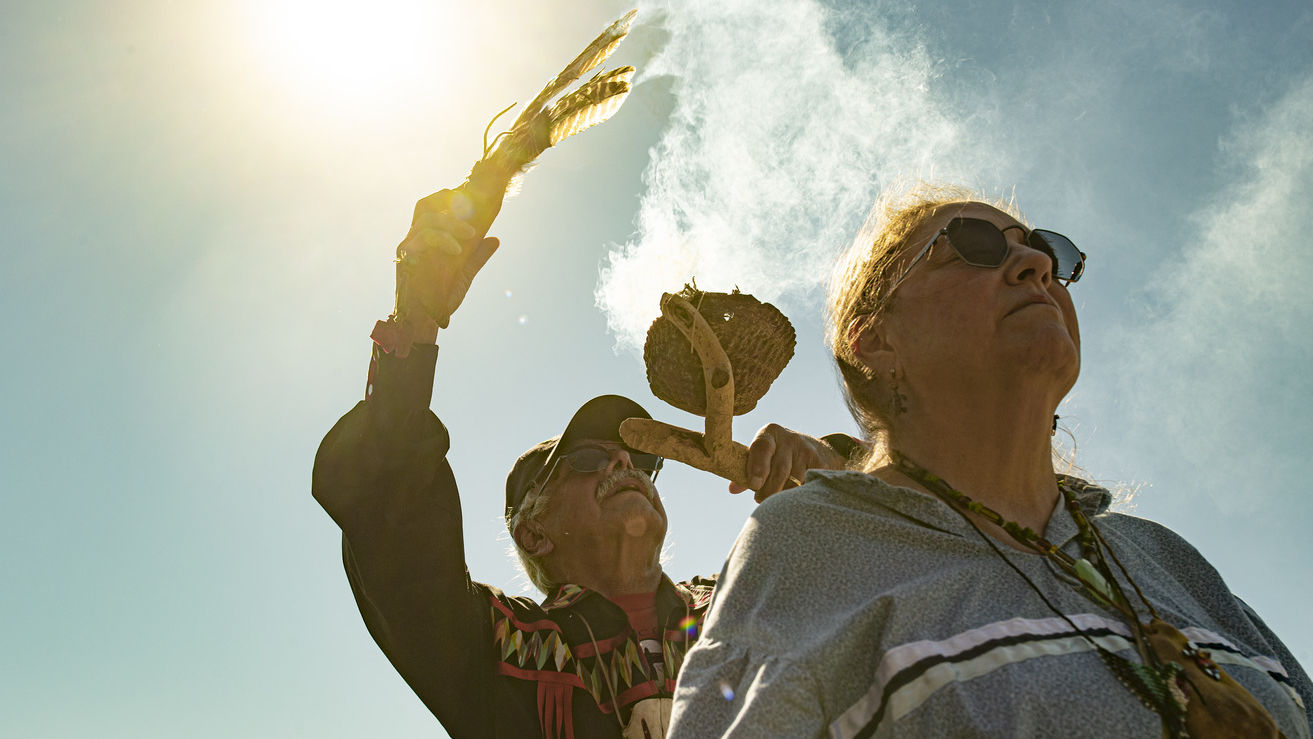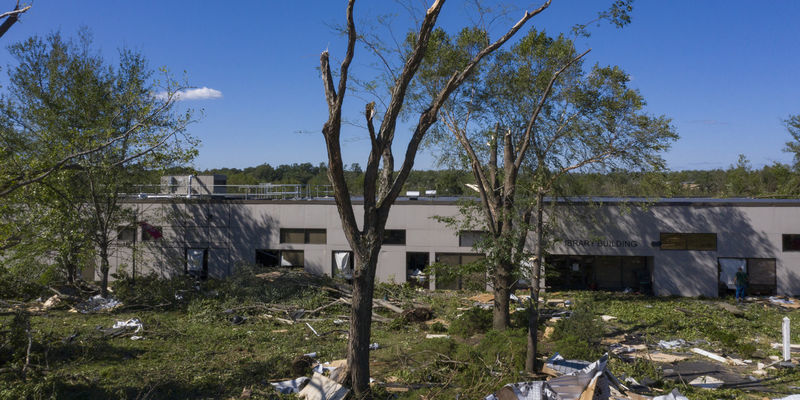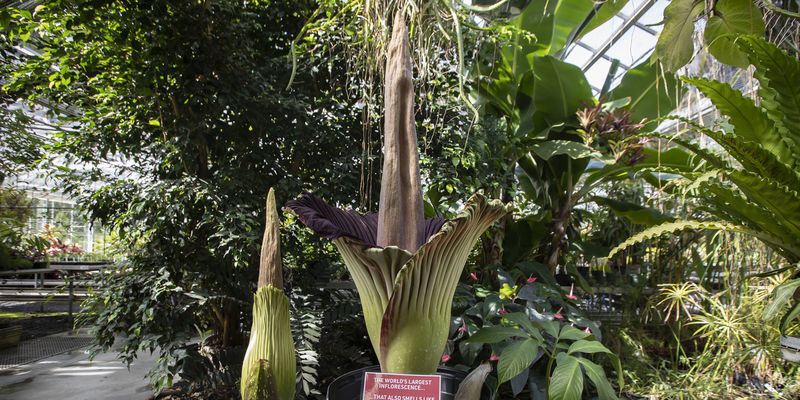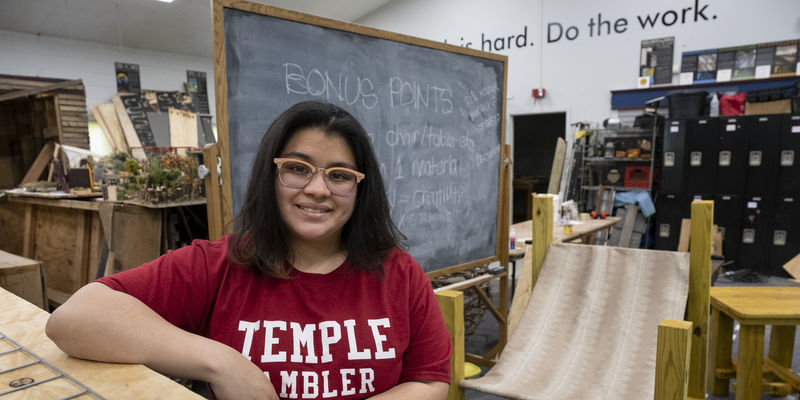A ceremony to heal the land and the heart
The Lenape Nation of Pennsylvania led a Healing Ceremony at Temple Ambler, which was badly damaged by a tornado in September.

The calming rhythm of a drumming circle. Tribal stories as relevant today as the first time they were told. An emotional blessing in the Lenape-Unami dialect. The cleansing scent of burning sage. A dance of friendship and community.
The Lenape Nation of Pennsylvania visited Temple University Ambler and the Ambler Arboretum to help the campus and the surrounding community heal and reconnect with the land that has been irrevocably scarred by an EF2-level tornado that tore through the region on Sept. 1.
“We are all related to everyone and everything around us. We come together to help the Earth heal—we thank the Earth, the four seasons and all living things,” said Chief of Ceremonies and Lenape Nation of Pennsylvania Tribal Council Member Chuck Gentlemoon DeMund to a gathering of more than 100 Temple students, faculty, staff, community members and friends of the campus and arboretum. “Sitting here, standing here in this place, you all have free will but something brought you here. Today, we are all part of the Creator’s dream.”
According to DeMund and Adam Waterbear DePaul, CLA ’08, tribal council member and storykeeper of the Lenape Nation of Pennsylvania, the Lenape Nation has strong connections to Temple University, the Ambler Campus in particular.
“When [Arboretum Director] Kathy Salisbury reached out after the tornado to see if there was something that we could do to help the campus and community heal, we, of course, wanted to do whatever we could,” he said. “This is an important place for us—we are grateful to the many people on this campus who are such conscientious stewards of the environment and the Lenapehoking (translated as ‘homelands of the Lenape’).”
According to Salisbury, to date 507 trees have been identified as killed when the tornado ripped through campus.
“When something as catastrophic as a tornado devastates the campus, damaging buildings, destroying thousands of books, short-circuiting our technology and creating an unrecognizable landscape in its path, what do we do? While we grieve what has been lost and continue the process of recovery, we look towards the future,” she said. “We assess, adjust, adapt. We press on. But we are also still mourning. We grieve. With the Lenape Nation of Pennsylvania, we have joined together to collectively heal and we are so grateful for their support and compassion.”
A healing ceremony “is more of a restoration of energy,” said DeMund, who also leads the tribal drum group the Itchy Dog Singers and has a long history of participating in the Cherokee Pow Wow that was held for years at Temple Ambler during the Memorial Day weekend.
“I’m hoping that through our songs and ceremonies that people gain an understanding of the connections between everything,” he said. “It’s tough to be a two-legged, because we’re taught that we are greater than everything else and that’s just not how it should be. We are part of everything. We are equal to the smallest ant, the greatest eagle—we’re all connected.”
During the ceremony, DePaul shared stories of the Cyclone, the Thunders, the Great Serpent, the Great Toad and more; connecting those cherished stories with the events of today. DePaul has a very personal connection to Temple Ambler. He completed his undergraduate degree with a double major in philosophy and English and a psychology minor at the Ambler Campus. He is currently a PhD candidate at Temple with primary research areas in cultural and mythological studies, and a co-founder and officer of NAISAT (Native American and Indigenous Studies at Temple).
“Temple Ambler was absolutely essential for me on my journey—it was the most important time in my life. I came from the Poconos; I knew the city wasn’t the right entry point for me toward getting a college degree,” he said. “My father went to Temple and he took some courses at Temple Ambler—he told me to give it a look. Here, I could still be around the trees and around nature while I was getting my degree. That changed the course of my life. I might not be completing my doctoral degree without that decision.”
Following the ceremony, attendees worked together to plant several new trees in the Ambler Campus Learning Center quad, a location severely impacted by the tornado.
“Horticulture is an integral part of our culture. Plants are more than just the backdrop to our lives, and, in fact, without them there is no life,” Salisbury said. “On this campus, not only are trees, and the landscape, life-sustaining, they are our living textbooks, our all-natural lab equipment, our living, breathing lessons.”
Students, faculty, arboretum staff, Temple Ambler Field Station researchers and researchers from outside the university will continue “learning, teaching and contributing to the body of scientific knowledge from the process of clean up and recovery, and from the landscape,” Salisbury said.
“There were so many lessons left in those trees while they stood, but we can learn new lessons from them, in their new state,” she said. “Researchers can learn about the life the tree lived by looking at the patterns in the rings, its age, if there were droughts, if it was struck by lightning, how many good years of growth it had and how many challenging years it had. Even the stumps have lessons to teach us.”
—James Duffy


